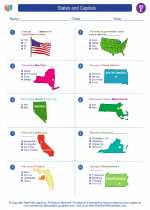States and Capitals -> regions
Regions: Exploring the Different Areas of the World
Regions are areas of the world that share common characteristics, such as culture, language, geography, and history. These characteristics can help us understand how different parts of the world are similar and different from one another.
Types of Regions
There are different types of regions, including:
- Formal Regions: These are regions with clearly defined boundaries, such as countries or states. They are characterized by common political, cultural, or physical features.
- Functional Regions: These regions are defined by a central point and the surrounding areas that are connected to that point. For example, a city and its suburbs form a functional region.
- Vernacular Regions: Also known as perceptual regions, these are regions that are based on people's perceptions and feelings. For example, the "American South" is a vernacular region based on cultural and historical perceptions.
Why Regions Matter
Studying regions helps us understand the diversity of the world and the connections between different places. It also allows us to explore how geography, history, and culture have shaped different parts of the world.
Study Guide
Here are some key points to remember when studying regions:
- Identify the different types of regions and give examples of each type.
- Explain why regions are important for understanding the world.
- Compare and contrast two different regions, focusing on their cultural, geographical, and historical differences.
- Create a map showing the formal, functional, and vernacular regions of a country or continent.
- Discuss how the concept of regions can help us better understand global issues such as migration, trade, and cultural exchange.
Understanding regions is an essential part of learning about the world and its diverse communities. By exploring regions, we gain valuable insights into the interconnectedness and uniqueness of different areas of the world.
.◂Social Studies Worksheets and Study Guides Fifth Grade. States and Capitals

 Worksheet/Answer key
Worksheet/Answer key
 Worksheet/Answer key
Worksheet/Answer key
 Worksheet/Answer key
Worksheet/Answer key
